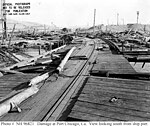Simmons Island
Islands of Northern CaliforniaIslands of Solano County, CaliforniaIslands of Suisun BayIslands of the San Francisco Bay AreaSan Francisco Bay Area geography stubs

Simmons Island is a small island in Grizzly Bay (part of Suisun Bay) in the San Francisco Bay Area of California. It is part of Solano County, and included within Reclamation District 2127. Its coordinates are 38°05′49″N 121°59′26″W. It is shown as "Simmons Island" on an 1850 survey map of the San Francisco Bay area made by Cadwalader Ringgold, and as "Simons Island" on an 1854 map of the area by Henry Lange. It is labeled, along with Deadman Island, Joice Island, Grizzly Island, Ryer Island and Roe Island, on a 1902 USGS map of the area.
Excerpt from the Wikipedia article Simmons Island (License: CC BY-SA 3.0, Authors, Images).Simmons Island
Geographical coordinates (GPS) Address Nearby Places Show on map
Geographical coordinates (GPS)
| Latitude | Longitude |
|---|---|
| N 38.096944444444 ° | E -121.99055555556 ° |
Address
California, United States
Open on Google Maps






